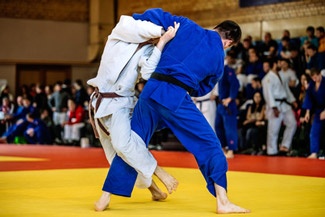Can having the right color jersey help you win the match?
 Have you ever heard an athlete complain that they weren't wearing their lucky jersey after losing a game? Athletes are often superstitious, and sometimes they may focus on the color of their uniform. But lots of people think that an athlete's chances of winning depend on the color they're wearing. A study on judo looked into just this question. To win a fight, is it better to have a blue or white judogi?
Have you ever heard an athlete complain that they weren't wearing their lucky jersey after losing a game? Athletes are often superstitious, and sometimes they may focus on the color of their uniform. But lots of people think that an athlete's chances of winning depend on the color they're wearing. A study on judo looked into just this question. To win a fight, is it better to have a blue or white judogi?Evolutionary psychologists are interested in the influence of color on athlete performance during competition. For example, they consider what are called “red effects:" (empirical) evidence of the positive influence of wearing red in a competition. They attribute these effects to the intimidating nature of the color on adversaries; certain studies have even shown a link between the color red and an increase in heart rate, physical strength, and higher levels of testosterone... Other research has suggested that color effects aren't necessarily limited to red.
Based on results from the 2004 Olympic Games, a study has suggested that judokas that wear blue win more often than those wearing white. The authors (Rowe et al., 2005) have put forth two hypotheses to explain these observations. First, the white judogi is more visible, allowing the athlete in blue to better assess and anticipate the movements of his or her opponent. Second, the blue uniform may have an intimidating effect. While other research has contradicted this study, the “fact” that there is a winning bias for the color blue remains well established.
Unlike previous studies on the subject, the research carried out by P. Dijkstra (Department of biology at Central Michigan University) and his colleague P. Preenen (Netherlands Organisation for Applied Scientific Research) builds on a large data set that includes the results of Olympic Championships, World Championships, World Cups, Grand Prix, Grand Slam tournaments and European Championships. It includes a total of 162 tournaments, 45,874 competitions in 14 weight categories (7 each for the women's and men's divisions).
In judo, the first athlete called for the fight wears the blue judogi. But this was only true up until 2011; since then the judoka in white is called first to the tatami. This change allowed scientists to compare the number of victories before and after the change in order to isolate the effect of color.
And the results of the statistical analysis quickly put an end to the debate: color has no influence on winning in judo. But while wearing a blue judogi won’t guarantee a victory; being called first (regardless of uniform color) could improve the chances of winning the fight! Thus, another bias has been brought to light.
To illustrate their study, the authors used the example of Teddy Riner. This two-time French Olympic medalist and 10-time world champion has fought both in blue and white. He remains undefeated since 2010. Let’s hope he gets called first to the tatami even more often! What can you do? The author of this article happens to be a superstitious French fan...
Source: Peter D. Dijkstra, Paul TY Preenen, Hans van Essen. “Does blue uniform color enhance winning probability in judo contests?”, in Frontiers in Psychology , Jan. 2018 // Rowe, C., Harris, J. M., and Roberts, S. C. “Sporting contests: seeing red? Putting sportswear in context”, in Nature 437, E10. 2005







